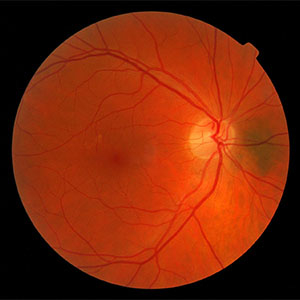Choroidal Nevus
A nevus is a freckle or a “birthmark.” Just as freckles, moles, and birthmarks can occur anywhere on your body on your skin, a nevus can also be present inside your eye. They are most often seen in the pigmented layer beneath the retina called the choroid. A choroidal nevus can only be seen by an eye doctor using specialized diagnostic instruments to look through your pupil to the back of your eye.
Is a Choroidal Nevus Dangerous?
Typically, a choroidal nevus will remain benign and cause no problems. However, like freckles and moles on your skin, a choroidal nevus can develop into a malignant melanoma in rare cases.
If I Have a Nevus, Should It Be Treated?
Typically, a choroidal nevus requires no treatment. Some choroidal nevi have features that make them higher risk for developing into a melanoma than others. It is these nevi that should be observed closely through scheduled examinations with your eye doctor, who will carefully document the appearance and features of your nevus to determine how often you need to be re-examined going forward.
How Often Should I Get Re-Examined?
All choroidal nevi should be examined at least annually. If your eye doctor notices certain features on your nevus, you may need to be checked more frequently. For example, if the nevus is particularly large or thick, has orange pigment, or is leaking fluid, then it is more likely to develop into a melanoma. Your doctor will decide how often to recheck your nevus to decide if it has grown into a melanoma.
How Is My Nevus Checked by the Doctor?
All choroidal nevi require careful examination and documentation by an eye doctor. Some nevi require additional testing. Testing may include the use of an ultrasound B-scan of the eye, photography of the affected area, or an angiogram along with photographs. These tests are useful to carefully document the size, shape, and characteristics of your nevus, and to determine if changes have occurred over time or if it is staying the same on future examinations.
Does a Choroidal Nevus Typically Affect My Vision?
In the vast majority of cases, a nevus causes no visual symptoms. In rare cases, a nevus can cause a blind spot in the vision of the eye in which it is present. Sometimes visual changes are a sign of other problems or that a nevus has begun to change into a choroidal melanoma. Any visual changes should be reported to your eye doctor and a comprehensive eye examination should be scheduled as soon as possible.



